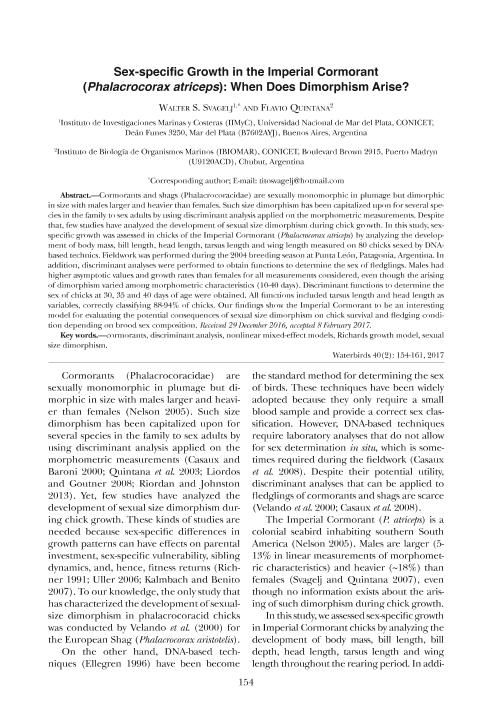Mostrar el registro sencillo del ítem
dc.contributor.author
Svagelj, Walter Sergio

dc.contributor.author
Quintana, Flavio Roberto

dc.date.available
2018-11-20T19:51:39Z
dc.date.issued
2017-06
dc.identifier.citation
Svagelj, Walter Sergio; Quintana, Flavio Roberto; Sex-Specific Growth in the Imperial Cormorant (Phalacrocorax atriceps): When Does Dimorphism Arise?; Waterbird Society; Waterbirds; 40; 2; 6-2017; 154-161
dc.identifier.issn
1524-4695
dc.identifier.uri
http://hdl.handle.net/11336/64787
dc.description.abstract
Cormorants and shags (Phalacrocoracidae) are sexually monomorphic in plumage but dimorphic in size with males larger and heavier than females. Such size dimorphism has been capitalized upon for several species in the family to sex adults by using discriminant analysis applied on the morphometric measurements. Despite that, few studies have analyzed the development of sexual size dimorphism during chick growth. In this study, sexspecific growth was assessed in chicks of the Imperial Cormorant (Phalacrocorax atriceps) by analyzing the development of body mass, bill length, head length, tarsus length and wing length measured on 80 chicks sexed by DNA-based technics. Fieldwork was performed during the 2004 breeding season at Punta León, Patagonia, Argentina. In addition, discriminant analyses were performed to obtain functions to determine the sex of fledglings. Males had higher asymptotic values and growth rates than females for all measurements considered, even though the arising of dimorphism varied among morphometric characteristics (10-40 days). Discriminant functions to determine the sex of chicks at 30, 35 and 40 days of age were obtained. All functions included tarsus length and head length as variables, correctly classifying 88-94% of chicks. Our findings show the Imperial Cormorant to be an interesting model for evaluating the potential consequences of sexual size dimorphism on chick survival and fledging condition depending on brood sex composition.
dc.format
application/pdf
dc.language.iso
eng
dc.publisher
Waterbird Society

dc.rights
info:eu-repo/semantics/openAccess
dc.rights.uri
https://creativecommons.org/licenses/by-nc-sa/2.5/ar/
dc.subject
Cormorants
dc.subject
Discriminant Analysis
dc.subject
Nonlinear Mixed-Effect Models
dc.subject
Richards Growth Model
dc.subject
Sexual Size Dimorphism
dc.subject.classification
Otras Ciencias Biológicas

dc.subject.classification
Ciencias Biológicas

dc.subject.classification
CIENCIAS NATURALES Y EXACTAS

dc.title
Sex-Specific Growth in the Imperial Cormorant (Phalacrocorax atriceps): When Does Dimorphism Arise?
dc.type
info:eu-repo/semantics/article
dc.type
info:ar-repo/semantics/artículo
dc.type
info:eu-repo/semantics/publishedVersion
dc.date.updated
2018-10-23T14:10:25Z
dc.identifier.eissn
1938-5390
dc.journal.volume
40
dc.journal.number
2
dc.journal.pagination
154-161
dc.journal.pais
Estados Unidos

dc.journal.ciudad
De Leon Springs
dc.description.fil
Fil: Svagelj, Walter Sergio. Consejo Nacional de Investigaciones Científicas y Técnicas. Centro Científico Tecnológico Conicet - Mar del Plata. Instituto de Investigaciones Marinas y Costeras. Universidad Nacional de Mar del Plata. Facultad de Ciencia Exactas y Naturales. Instituto de Investigaciones Marinas y Costeras; Argentina
dc.description.fil
Fil: Quintana, Flavio Roberto. Consejo Nacional de Investigaciones Científicas y Técnicas. Centro Científico Tecnológico Conicet - Centro Nacional Patagónico. Instituto de Biología de Organismos Marinos; Argentina
dc.journal.title
Waterbirds

dc.relation.alternativeid
info:eu-repo/semantics/altIdentifier/url/http://www.bioone.org/doi/10.1675/063.040.0207
dc.relation.alternativeid
info:eu-repo/semantics/altIdentifier/doi/https://dx.doi.org/10.1675/063.040.0207
Archivos asociados
